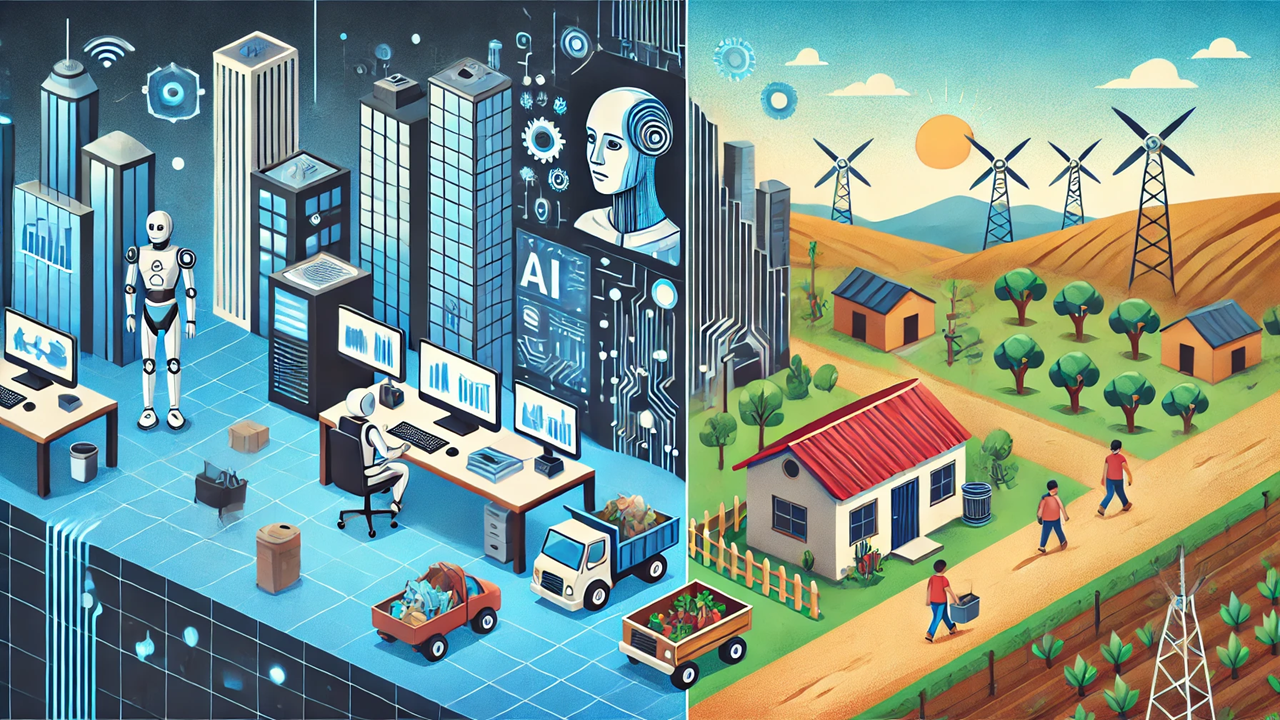Generative AI and the Digital Divide: A Double-Edged Sword for Latin America's Job Market
A recent World Bank report reveals that Generative AI (GenAI) has the potential to significantly impact the job market in Latin America and the Caribbean (LAC). While it offers new opportunities for productivity, the region's digital divide threatens to widen inequality, leaving many jobs, especially those in lower-income countries, unable to benefit from technological advancements. The study emphasizes that the jobs most affected by GenAI are urban, high-income, and held by educated workers in formal sectors, particularly in finance and public services. However, half of these roles face barriers due to limited access to digital tools, potentially transforming this opportunity into a bottleneck for progress.

A New Frontier or a Bottleneck? GenAI's Impact on Latin America's Job Market
The rise of Generative Artificial Intelligence (GenAI) promises to reshape industries and economies globally. However, for the Latin America and Caribbean (LAC) region, this transformative technology presents a paradox. While it could boost productivity and streamline various sectors, a critical digital divide threatens to leave millions of workers behind. A new report titled Buffer or Bottleneck? Employment Exposure to Generative AI and the Digital Divide in Latin America by the World Bank highlights these contrasting effects, examining the potential for GenAI to either bolster or hinder the LAC region’s labor markets.
High Exposure, Uneven Benefits
According to the report, GenAI is expected to touch nearly 30-40% of the region’s job market, especially in urban, formal-sector jobs. These positions tend to require higher levels of education and are more commonly held by younger workers, who are already familiar with digital technologies. Sectors like finance, public administration, and insurance are seen as the most exposed to GenAI—offering new productivity tools but also bringing the risk of job automation.
However, the report reveals a troubling reality: the majority of workers poised to benefit from GenAI are those who already have access to the necessary technology, which is typically limited to higher-income countries and wealthier individuals. Workers in poorer countries and rural areas face significant hurdles, as many still lack access to the digital tools essential for leveraging GenAI's full potential. This gap in digital infrastructure could prevent these economies from realizing the productivity benefits that more advanced regions stand to gain.
The report highlights that in lower-income nations like Nicaragua, Guatemala, and Honduras, nearly half of the jobs that could benefit from GenAI enhancements are hindered by the lack of digital technology. This barrier could exacerbate existing inequalities, turning GenAI from a tool for advancement into yet another factor deepening the divide between rich and poor nations.
Sectors Most at Risk of Automation
While the conversation around AI often sparks concern about job loss, particularly through automation, the report’s findings suggest a more nuanced reality for LAC. Sectors like education, healthcare, and personal services show a high potential for productivity boosts through GenAI. However, sectors such as finance and insurance are more likely to experience automation risks.
Younger workers, especially women, are seen as the most exposed to GenAI-driven job changes, including potential job losses through automation. For example, clerical and administrative roles, often held by women, may face a higher risk of being replaced by AI-driven technologies in these sectors.
Still, the potential for job transformation through GenAI remains promising. Jobs that involve personal interaction, such as in education or healthcare, are less likely to be fully automated. These sectors might see substantial gains from AI-augmented productivity, allowing workers to focus more on creative, decision-making tasks, while AI handles routine processes.
The Digital Divide: A Barrier to Progress
At the heart of the issue is the persistent digital divide in Latin America, a well-documented challenge that has become more pronounced with the arrival of GenAI. Nearly half of the jobs that could benefit from GenAI-powered productivity gains are stymied by the lack of access to digital technologies in the workplace.
This disparity is most evident in poorer countries, where many workers lack even the most basic tools—such as computers or reliable internet access—needed to use AI effectively. As a result, the gap between urban and rural areas is likely to widen further, with the digital haves moving ahead while the have-nots fall behind. In the LAC region, workers in low-income countries are doubly disadvantaged—not only are they less likely to be exposed to GenAI, but even when they are, the absence of digital infrastructure prevents them from realizing the full potential of this technology.
This situation poses a significant challenge for policymakers, who are now tasked with not only improving digital infrastructure but also ensuring that workers can adapt to and leverage GenAI for productivity and career growth.
Government Intervention: The Need for a Safety Net
The report emphasizes the urgent need for government intervention to address the growing disparities in the region's workforce. It suggests that policies aimed at expanding digital infrastructure, improving access to technology, and fostering digital skills are critical to maximizing the positive impacts of GenAI. Without these measures, LAC nations risk creating a labor market where the divide between high-income and low-income workers widens even further.
Moreover, social protection policies, such as unemployment benefits, retraining programs, and initiatives that promote digital literacy, will be crucial to supporting workers through this transition. As the report notes, the introduction of GenAI could provide an unprecedented opportunity to improve productivity and create new job categories in education, healthcare, and customer services, but only if the barriers created by the digital divide are addressed.
- FIRST PUBLISHED IN:
- Devdiscourse
ALSO READ
China's Trade Surge in Peru: Navigating a New Latin American Landscape
The Economic Cost of Crime in Latin America: A Budgetary Strain
China's Maritime Vision: Xi's Bold Belt and Road Expansion in Latin America
Poverty on the Decline in Latin America as Brazil Leads the Charge
Biden's Crucial Diplomatic Balancing Act in Latin America










